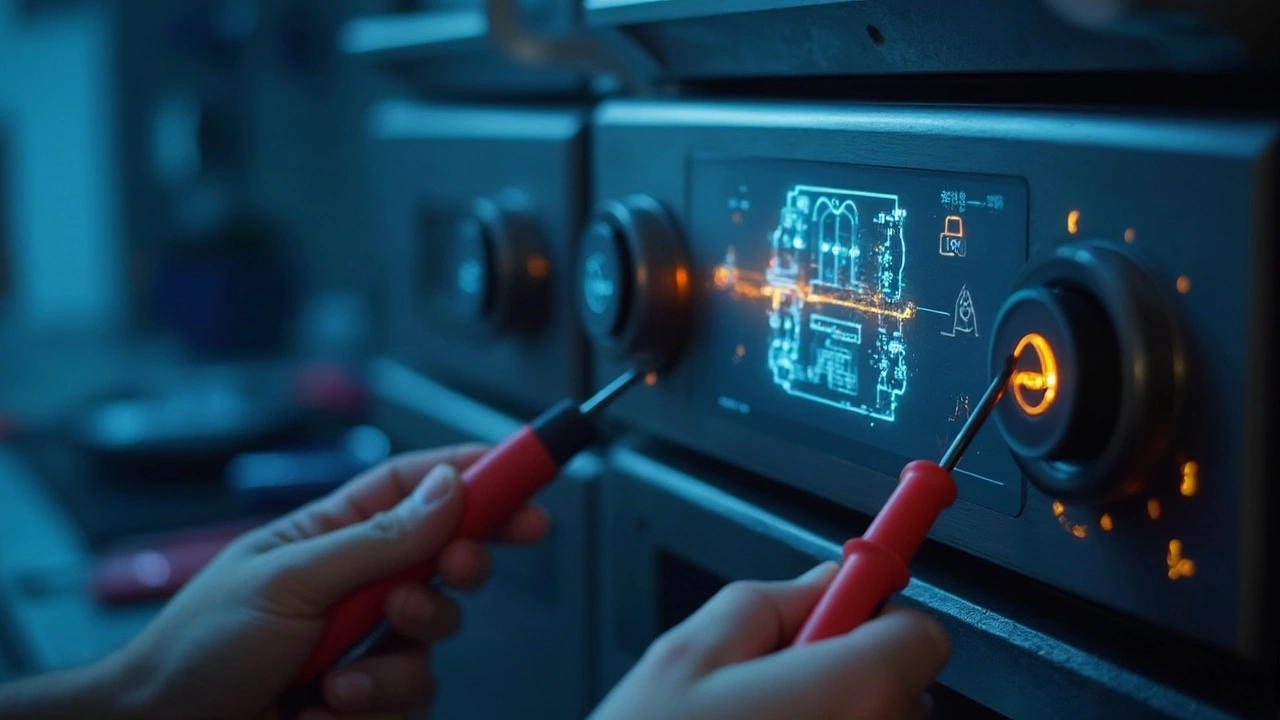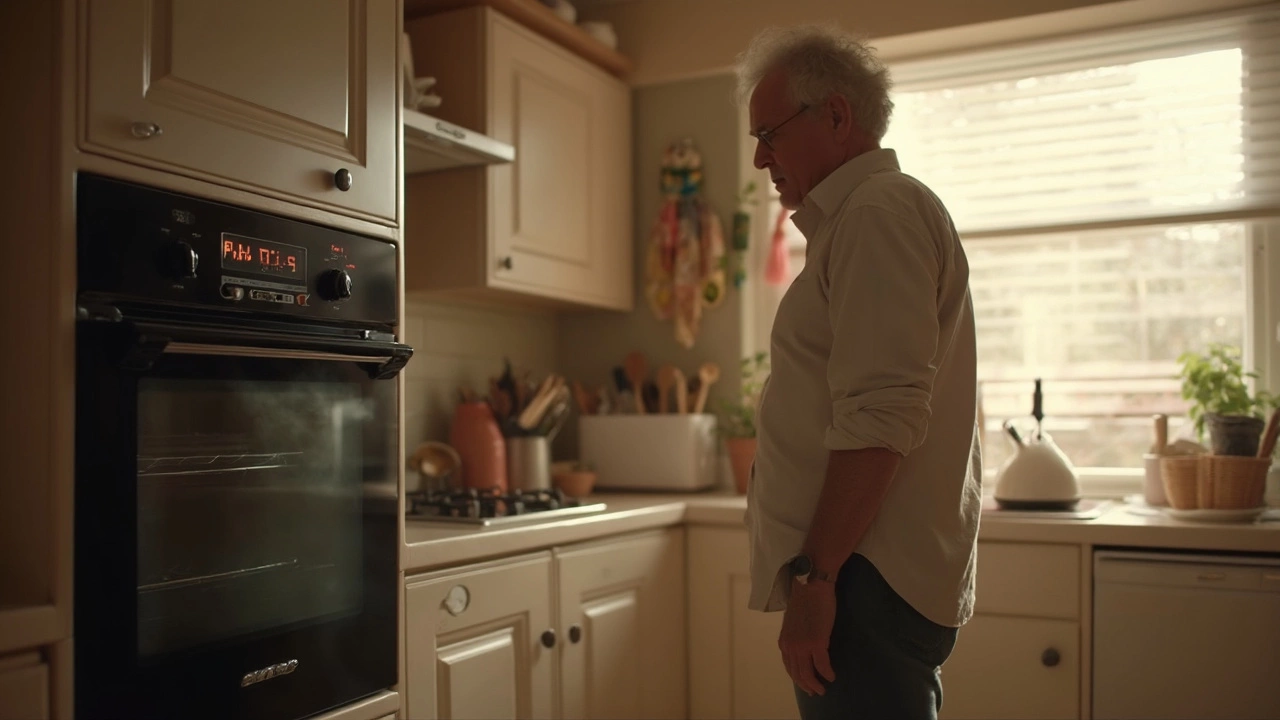Your oven suddenly starts behaving like it has a mind of its own—buttons not responding, weird error codes popping up, maybe it just refuses to turn on. Nine times out of ten, people blame the heating element or the sensors, but the real culprit might be the control board. This little circuit board is basically the boss of all the oven’s operations, telling it when to heat, what temperature to hold, and how to react when you push those buttons.
If your display is flickering, numbers jump around without you touching anything, or the oven ignores commands—those are red flags. Unreliable temperature is another giveaway. Ever noticed your cookies burning at 250°F or taking forever at 400°F? That could be the board losing its grip. Some folks even run into ovens that suddenly lock themselves or won’t unlock after a self-clean cycle, which is usually a control board gone haywire.
But before jumping to conclusions and dropping cash on a new part (or a new oven), it helps to check a few things. Sometimes the fix is stupidly simple, like a loose wire or a blown fuse. Grab your model’s manual, see if there’s a way to reset the electronics, and make sure the connections are snug. If the problems keep coming back right after a reset, then it’s time to take that control board nonsense seriously.
- How the Oven Control Board Actually Works
- Clear Signs Your Control Board Is Failing
- Quick Checks Before You Panic
- Common Causes of Control Board Failure
- Repairing or Replacing: What’s Next?
How the Oven Control Board Actually Works
The control board is like the oven’s command center. It’s a small electronic circuit board—usually tucked behind the control panel—that takes your button pushes or knob turns and sends out power signals to all the different oven parts.
When you punch in a temperature or cooking mode, the control board tells the heating elements when to turn on, for how long, and at what intensity. It also gets feedback from temperature sensors to make sure your electric oven holds steady at the temperature you ask for. If things get too hot or too cold, the board tells the elements to adjust. It even knows when to lock the oven door during self-clean cycles and manages the timers you set for baking or broiling.
No joke—it’s basically the oven’s brain, but instead of thinking deep thoughts, it’s constantly flipping switches to keep things working like a well-oiled machine. Messed up control signals? The heating elements get confused and food cooks unevenly.
Here's a super quick breakdown of what the control board handles in most modern electric ovens:
- Reads input from buttons, touchpads, or dials
- Sends power to heating elements (bake, broil, convection)
- Communicates with temperature sensors
- Controls the oven light, timers, and digital display
- Manages safety features like oven door locks and error codes
If just one of these circuits gets fried or a part goes bad, your oven could do anything from ignore you completely to blasting at full heat nonstop. That’s why pinpointing control board issues is crucial for reliable oven repair.
Modern ovens are packed with electronics—while that means slick features and better energy control, it also puts more wear on the control board. According to appliance pros, nearly 20% of electric oven repairs involve this part alone. So if your oven acts strangely, the control board is a prime suspect.
Clear Signs Your Control Board Is Failing
No one likes guessing games in the kitchen. When your electric oven starts showing off weird habits, a bad control board is often the troublemaker. The signs usually sneak up on you and don’t always scream “replace me!” at first glance. Here’s what to look for before you blame every other part in your oven.
- Unresponsive control panel: If you push the buttons and nothing happens, or they only work sometimes, your control board could be fried. It’s not always a sticky button—sometimes the brain just isn’t sending out the signals.
- Weird or random error codes: Modern ovens love to flash error codes. If you see errors like F1, F3, or others you can’t find in the manual, that’s a classic clue the control board is glitching.
- Flickering or dead display: Blank screens, digits that flicker, or displays that look more like a Christmas tree than an oven? That usually points to board trouble, especially if the oven powers on but the clock or settings act up.
- Baking at the wrong temperature: When you set the oven to 375°F but your cookies are burning as if it’s set to broil, the control board may not be telling the heating element to stop when it should.
- Preheat that takes forever: Sometimes the oven warms up much slower, even though there’s nothing wrong with the element. That's also a sign the control board isn’t doing its job.
- Locked or stuck doors: If your oven door is randomly stuck after a self-clean cycle or won’t lock/unlock even though you hear a click, the board could be sending the wrong message to the lock motor.
- Random beeping: Does your oven beep like it’s trying to talk to aliens? Sometimes relentless audible alerts mean the board is completely confused.
Here's a simple view of what symptoms often tie back to a failing control board:
| Symptom | How Often It's Board-Related |
|---|---|
| Unresponsive buttons | Very common |
| Strange error codes | Common |
| Wrong temperatures | Frequently board-related |
| Dead display | Very common |
| Bizarre noises/beeping | Sometimes |
So if you spot one (or more) of these problems together, your electric oven might have a failing control board. But don’t jump to conclusions—other parts can sometimes mimic these symptoms. It really helps to see how your oven acts right after you flip the breaker or unplug it for a couple of minutes. If the weirdness comes right back, it’s a strong hint that the board is cooked.

Quick Checks Before You Panic
Before you assume your oven’s control board is toast, don’t skip some easy steps. Lots of “mystery glitches” in electric ovens are actually due to power issues, dirty contacts, or stuff you can fix yourself without any fancy tools.
- Check the basics: Is your oven actually getting power? Plug something else—the old toaster trick—into the outlet. If the outlet is dead, you probably just tripped a breaker or blew a fuse. Reset it at your panel and see if the oven wakes up.
- Try a hard reset: Unplug the oven or kill power at the breaker. Wait 60 seconds. Plug it back in. A hard reset can clear up software hiccups or temporary glitches in the control board.
- Inspect the display: Lots of flickers or garbled numbers? That can still be a power issue, not always a bad board. If it only acts up when you plug something else into the same circuit, you may need an electrician, not a repair tech.
- Check the control panel buttons: Gently press all of them. Stuck or sticky buttons throw off signals to the control board. It sounds basic, but a lot of users have pried off food crumbs to fix so-called “broken” ovens.
- Look for error codes: Some ovens flash codes like F1, F3, or F9 when the control board or sensors act up. Grab the model number, look up the codes in the manual or manufacturer’s site, and see what exactly is being reported.
About 40% of ovens sent for “control board replacement” are totally fine after a hard reset or cleaning up around the buttons and wiring. Here’s a quick reference for what’s worth checking before shelling out for repairs:
| Quick Check | Chance of Fixing |
|---|---|
| Breaker reset | 25% |
| Hard reset (unplug/replug) | 15% |
| Clean/control buttons | 10% |
| Error code lookup | Varies |
If your oven passes all these checks but still acts up, then maybe the control board really is out. But it’s always better to rule out the cheap fixes first.
Common Causes of Control Board Failure
When you start noticing your oven acting up, it’s easy to overlook what’s actually messing things up. Truth is, the control board is pretty sensitive, and a bunch of things can take it out. Knowing what goes wrong can help you spot the issues earlier or even prevent them in the first place.
Power Surges are one of the biggest offenders. Whenever there’s a sudden spike in your home’s electricity, it can fry tiny circuits on the board. Stormy summer nights or bad wiring in the house can push more power into the oven than it can handle. That’s why a surge protector is no joke—a small investment, but it can save the ‘brain’ of your oven.
Moisture is another sneaky culprit. Every time you cook, especially stuff with lots of steam or during self-clean cycles, moisture can creep inside the control panel. Some older ovens aren’t great at keeping that moisture out, and before you know it, corrosion forms on the board, messing with how it works.
You also have to look out for worn-out components. Over the years, relays (those little switches that click inside the oven) and connections on the electric oven board can just wear down. Heat—even though it’s exactly what your oven’s made for—can slowly bake the electronics, loosening connections or even burning up some parts if you use high temps a lot.
Here’s a quick breakdown of some of the common causes and what’s behind them:
- Voltage spikes from storms or power grid issues fry the board’s circuits
- Steam buildup during baking or boiling gets trapped near the panel and causes corrosion
- Heat stress slowly wrecks soldering points and circuit joints
- Physical knocks or repeated pressing of sticky buttons can break the contact points
- Grease or food splash seeps through tiny cracks and causes short circuits
If you’re into numbers, check this out:
| Cause | Estimated % of Failures |
|---|---|
| Power Surge | 35% |
| Moisture/Corrosion | 27% |
| Heat Damage | 20% |
| Physical Damage | 12% |
| Unknown/Other | 6% |
Simply put, the main thing to remember: keep your oven dry, use a surge protector, don’t slam the controls, and always wipe away spills. Doing these basic things can give your control board a much longer life—and you’ll spend less time googling fixes for your bad control board.

Repairing or Replacing: What’s Next?
Alright, so your control board really is acting up. At this point, you’re probably wondering if you should try fixing it, swap it out, or just drag your oven to the curb. Here’s a quick breakdown to help steer you in the right direction.
Start by checking your oven’s warranty. If it’s still covered, call the manufacturer or seller. Sometimes even labor is covered, and you don’t want to spend cash you don’t have to.
If you’re out of warranty, you basically have two solid choices: repair the control board or replace it with a new one. Repair is sometimes possible if it’s just a bad relay, a scorched resistor, or loose solder joints—which actually happens more than you’d think. But here’s the catch: You need to be comfortable with basic electronics, have a decent soldering iron, and not mind digging into the oven’s guts. Most folks just replace the control board because it’s way faster and doesn’t risk turning a $250 problem into a $700 disaster.
- Repairing: If you go this route, kits are available online, and some repair services let you mail your board for a professional fix. It might set you back $50–$100 if you DIY or $120–$180 if you use a mail-in service. Not bad if you’re handy and have the patience.
- Replacing: Buying a brand-new control board for your exact model can cost anywhere from $120 to $400, depending on the brand. Swapping it is usually plug-and-play; just unplug the oven, give yourself room to work, swap out the old board, connect the wires, and secure it in place. Make sure you buy the board made for your specific oven—using the wrong part will get you nowhere fast.
Here’s a quick price comparison so you know what to expect:
| Option | DIY Cost | Pro Service Cost |
|---|---|---|
| Repair (solder kit or send-off) | $50–$100 | $120–$180 |
| Replace (new board) | $120–$400 | $220–$550 |
If the oven is older (8–10 years or more) and the total repair or replacement cost gets close to half the price of a new oven, it’s worth thinking hard about just upgrading. Ovens don’t last forever, and there’s no point pouring money into something that’ll fail again soon.
Above all, safety matters. Whenever you’re messing with anything electrical, unplug your oven first. If you’re unsure, grab a friend who knows what they’re doing or call a certified pro. A working oven is awesome, but avoiding electrical shocks is even better.


